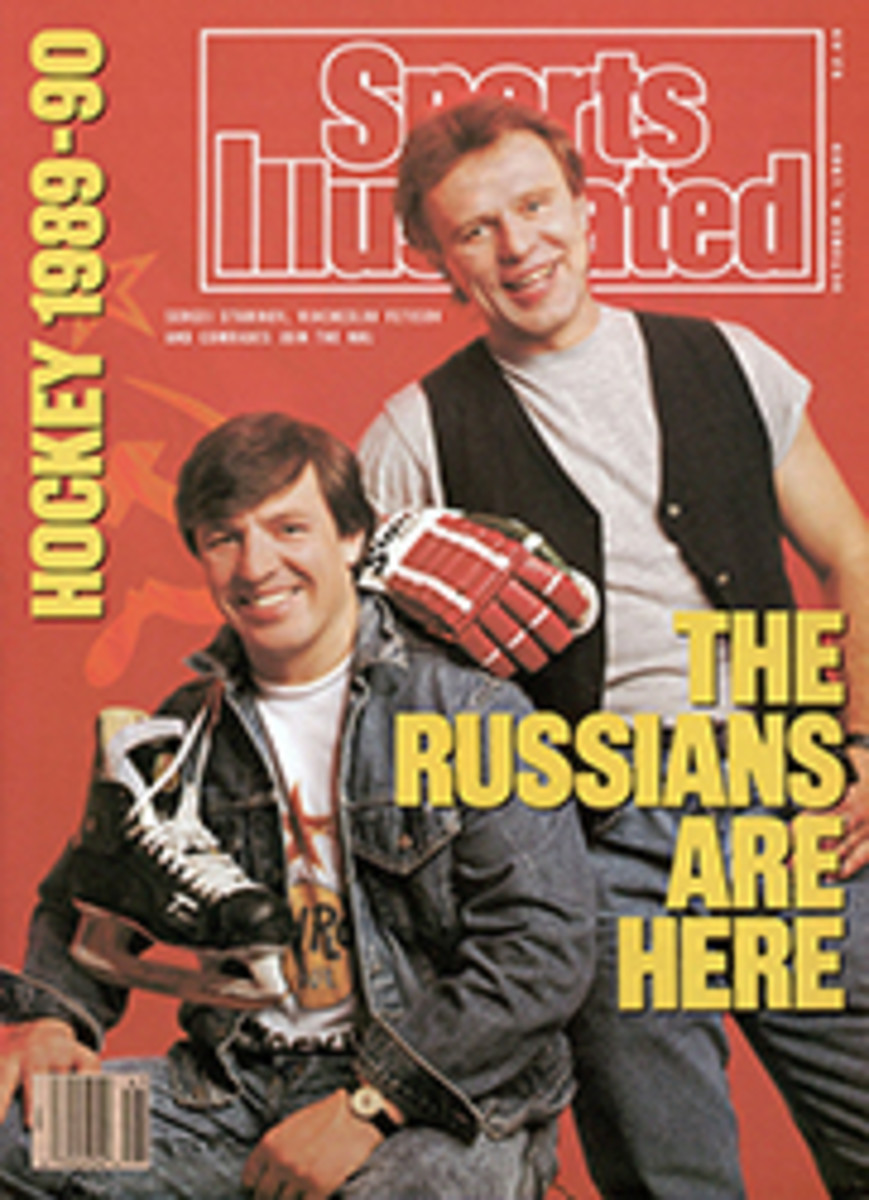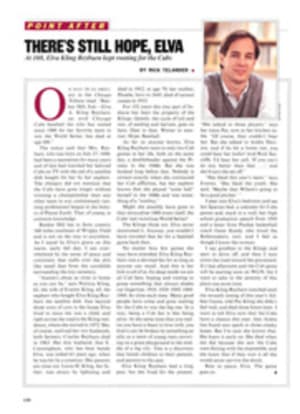
Letters
HOUNDING HUTSON
Regarding your story about Bronko Nagurski and Don Hutson (The Bronk and the Gazelle, Sept. 11): I played two games against Hutson in 1939, when I was a quarterback, a defensive halfback and a punter for the Detroit Lions. Floyd Cardwell and I double-teamed Hutson every time he left the line of scrimmage, and while he caught two touchdown passes, of 60 and 51 yards, to lead Green Bay to a 26-7 victory in the first game, we held him to only four receptions and 31 yards in the second. (Green Bay won nonetheless, 12-7.) Hutson's main assets were deceptive speed and wonderful hands. He would be great today, too.
JOHN PINGEL
Grosse Pointe, Mich.
LION-SIZED MOUSE
I have known Darrel (Mouse) Davis, the Detroit Lions' offensive guru (Building a Better Mouse Trap, Sept. 11), since 1972, when he coached Hillsboro (Ore.) High. His mental agility and his contributions to exciting run-and-shoot football are without question. It amazes me, though, that Davis's ability to motivate players does not receive more attention. He is a dynamic teacher who has made the sport fun for those lucky enough to have played for him.
KEN WOODY
Athletic Director, Lewis-Clark State College
Lewiston, Idaho
BIG-HEARTED FALCON
Thank you for giving Atlanta Falcon running back John Settle the recognition he deserves (Soaring into the '90s, Sept. 11). After he played in last season's Pro Bowl, a reporter asked him how he felt about the fact that he was not earning the big bucks that other top backs were getting. Settle replied, "That's something I don't think of often. The game is what I enjoy."
I went to school with Settle at Appalachian State and was shocked when he wasn't drafted. With all the sophisticated tests the NFL scouts run on prospective players, they forget to measure one thing—heart.
BRIAN K. HOAGLAND
Belmont, N.C.
NOT ENOUGH REST?
After reading your article on the increasing number of injuries in major league baseball (Where Have All the Players Gone? Aug. 28), I think you underestimate the impact of scheduling. I compared the 1969 and '89 schedules of the New York Mets. In '89, the schedule was four days longer, which is not significant. What is significant is the difference in the number of scheduled days off. In '69, the Mets had 30 scheduled off-days, including the All-Star break. This year they had only 20. Moreover, 29 of those off-days in '69 fell between May and September can average of six per month), but this year the Mets had only 15 off-days (three per month) during that five-month span. With only half as many days off during the long, hot middle months of the season, more injuries are bound to occur.
The more demanding 1989 schedule was brought about by the elimination of doubleheaders (the Mets had 14 scheduled in '69, none in '89), a change obviously driven by the owners' desire to increase profits. That trend is not likely to change.
JONATHAN CHATINOVER
New York City
TENNIS ETIQUETTE
Steve Wulf's POINT AFTER (Sept. 11) was on the mark. As a former high school basketball player who now plays local tennis tournaments, I chuckle at the unwillingness of tennis players at all levels to tolerate distractions that athletes in other sports consider inconsequential. At my club. Frisbee-chasing dogs and bikini-clad sunbathers next to the courts are the norm, and we often have to dodge errant softballs and soccer balls that land on the court during play.
STEVEN B. STEINHARDT
Albany, N. Y.
I would like to ask Steve Wulf one question: When was the last time you saw a Kirk Gibson home run get returned?
Tennis requires an extremely high level of concentration because it requires, in addition to making the hit, thinking ahead three or four moves.
ARIK BEN-ZVI
New York City
THE KALAMAZOO
Thank you for publishing such a comprehensive article on the Kalamazoo River (Of Time and the River, July 24). The story impressed a tremendous number of people in the community who previously had not been concerned. As a result, a coalition of citizens and businesses has decided to add the river to its list of beautification projects.
MARY B. POWERS
Kalamazoo (Mich.) County Commissioner
SPORTSMAN
For years I thought I knew a lot about sports, but Douglas S. Looney has shown me that I was all wrong (A Most Unusual Man, Sept. 4). I often praised coaches like Barry Switzer and Jimmy Johnson for their ability to field top-notch teams year after year. Now I realize that the greatest coach in football is Roland Ortmayer, and he has reached this pinnacle without having appeared in one bowl game or ever having popped off about the rankings. Isn't it obvious? Ort for Sportsman of the Year.
WAYNE LARKIN
Cobleskill, N. Y.
I am a juvenile-court counselor specializing in substance abuse, and whenever I need to remember what's good with the world I head down to the University of La Verne to see Roland Ortmayer. As a football player and student at La Verne. I never skipped practice or one of Ort's football theory classes for fear of missing something. I also have kayaked with Ort and his wife, Corni, since I was 12. Every time I jump into my kayak I have to smile, because I learned from the best. Incidentally. Corni, thanks again for pulling me out of the Salt River in 1975.
JOE MUSCATO
Grants Pass, Ore.
RISING POWER
I enjoyed your special report Sports and Japan (Aug. 21), but you left out a milestone in Japanese sporting history. In May the Japanese national rugby team stunned the world—or at least the rugby world—by beating the Scottish national team 28-24. Scotland is one of the world's best rugby nations.
GREG HAWES
Arlington, Va.
In June I had the honor of working with the All-Japan lacrosse team at the International Friendship Games in Tokyo. Although lacrosse has been played seriously in Japan for only three years, more than a thousand university and high school students are now on teams. The International Friendship Games attracted more than 7,000 spectators to Olympic Stadium to watch the All-Japan team challenge St. Paul's School of Baltimore (St. Paul's won 9-3) and Johns Hopkins lake on Australia (Hopkins won 15-14). The fans were enthusiastic and seemed to embrace the sport.
JOHN ESPEY
Stony Brook, N. Y.
Any story on Japanese sports should include mention of Hironoshin (the Flying Fish) Furuhashi and Shiro Hashizume, two teenagers who stunned the swimming world in Japan's dark hours after World War II. Barred from the 1948 London Olympics because of lingering ill will following the war, they swam in a national meet held simultaneously in Japan that year; both surpassed not only the winning 1,500-meter freestyle time in London but also the world record. Their performances weren't recognized—also simply because they were Japanese.
In 1949 they came to Los Angeles and beat their own best times. On this occasion their clockings were recognized, and the Flying Fish was credited with having set the world mark. Furuhashi and Hashizume gave the Japanese psyche a big boost. I can't think of any other sports heroes who had as much of an impact on their country.
JOHN B. HOLWAY
Alexandria. Va.
Your brief report "Money Fuels the Honda Wonder" touched on many key factors contributing to our success in Formula One Grand Prix racing. However, I suggest that "Money Can't Buy Everything" would have been a more appropriate title. While it is true that Honda spends what is needed to get the job done (though if you divide the "reputed" figure of $100 million a year by two, you'll be closer to what Honda actually spends), we feel that our advantage comes not from our budget but from our policy of allowing our engineers to push themselves to their limits, to make suggestions without being afraid of failure and to work as a team. In McLaren International we have a partner committed to a similar philosophy.
YOSHINOBU NOGUCHI
Honda F/1 Public Relations Manager
Langley, England
In the short piece titled "Grandpa Would Be Pleased." Masato Mizuno of the Mizuno Corporation, maker of sporting goods, says. "We want to be able to meet every sports need.... And we want true internationalization. Those are our goals."
This statement strikes a chord of disaffection in those Americans who can't sell their goods in Japan because of Japanese trade restrictions.
Sportsmanship is a two-way street.
TODD STRASSBERG
New York City
CLEVELAND
As a loyal fan of the Cleveland Browns, Cavaliers and Indians, I read Michael Jaffe's PERSPECTIVE (Aug. 28) with a wince of instant recognition. The day the Browns traded Paul Warfield for a draft pick, I locked myself in the bathroom and cried. I must have been about nine. Remember the Indians' trades of Graig Nettles and Chris Chambliss? I used to put together All-Star teams of former Indians.
The day a team brings a championship to Cleveland, there will be an explosion of pent-up frustration.
THOMAS M. BAGNELL
Redondo Beach, Calif.
If The Catch of 1954 was before Michael Jaffe's time, then I'm sure he doesn't recall what happened in December of that year at Cleveland Municipal Stadium. Otto Graham and the Browns defeated Bobby Layne and the Lions 56-10 to win the NFL championship.
I would like to be able to say that Joe Montana and the 49ers are the best quarterback and football team I've ever seen, but that distinction belongs to Graham and the Browns of the late '40s and '50s. In the 10 seasons that Graham was with the Browns, he took them to the championship game every year and won seven times. That's as close to perfection as anybody has ever come in professional football.
Don't cry too long for Cleveland, because those dogs sure had their day.
JOHN FREDERICKSON
Danville, Calif.
PREDESTINED?
The day after the Chicago Bears traded quarterback Jim McMahon to the San Diego Chargers (Jilted Jim's Big McLove-In, Aug. 28), I came across a picture of a poster that McMahon posed for in August 1987. I know that the poster was designed to predict that the Bears would return to the Super Bowl, held that season in San Diego. But the caption, along with the message on McMahon's duffel bag, seems to have foreshadowed the trade.
DAVID CURTOYS
Stephenville, Texas
PHOTO
BILL SMITH/COSTACOS BROS.
Letters to SPORTS ILLUSTRATED should include the name, address and home telephone number of the writer and should be addressed to The Editor. SPORTS ILLUSTRATED. Time & Life Building, Rockefeller Center. New York. NY. 10020-1393.

